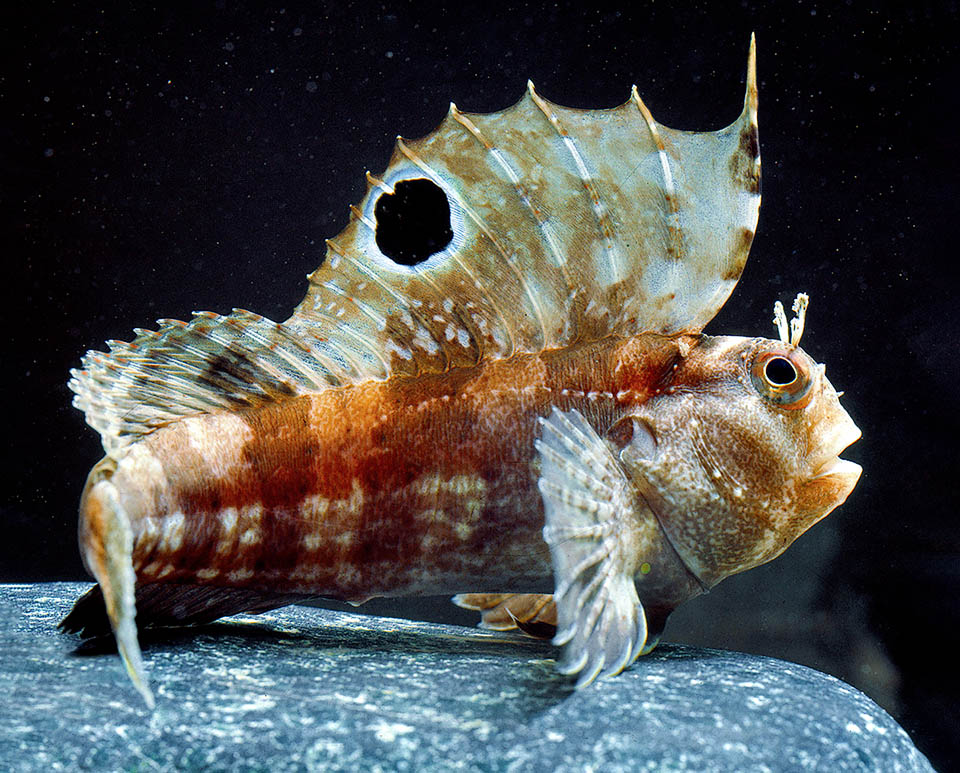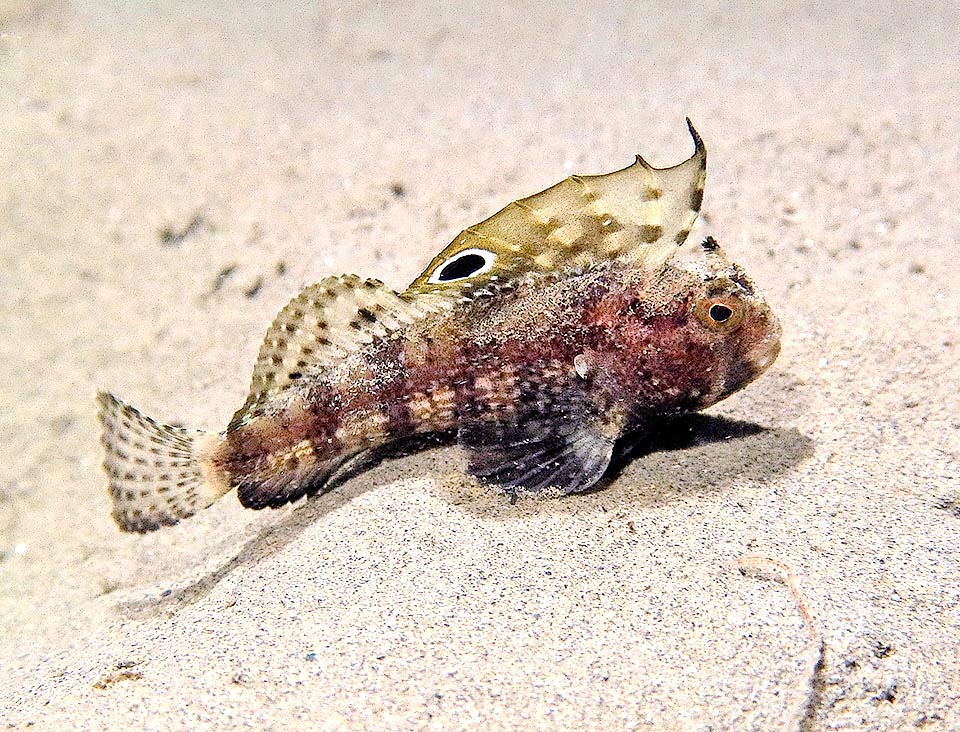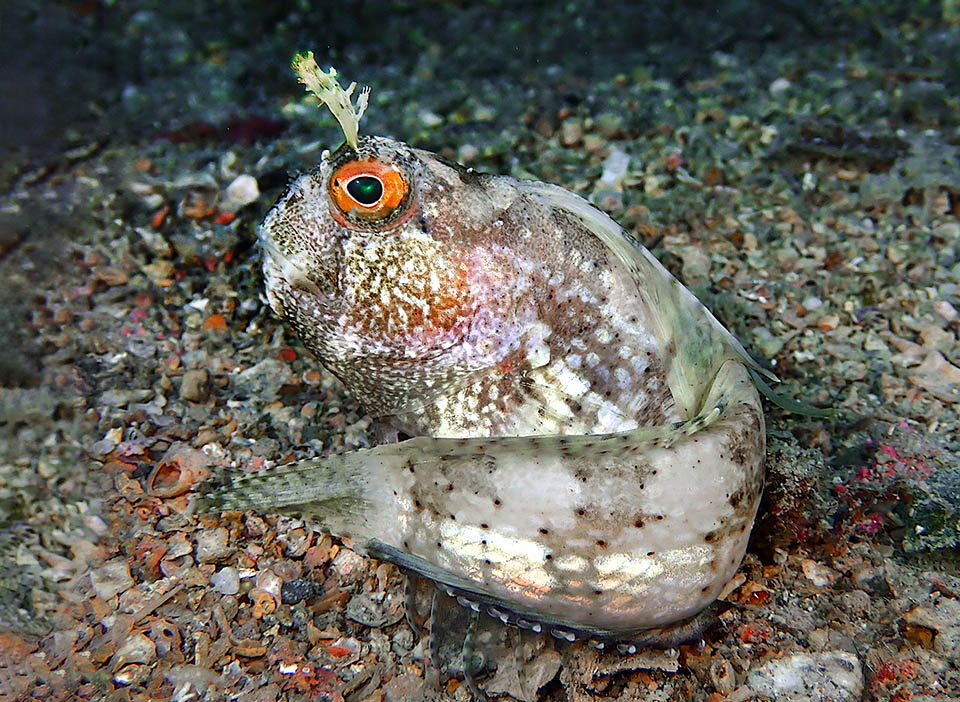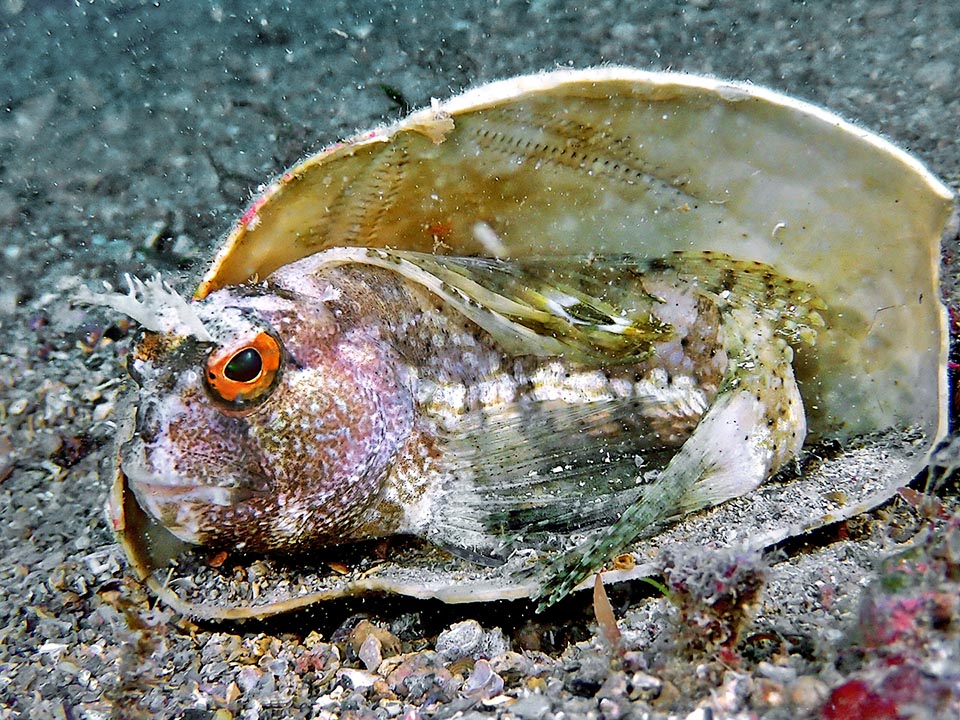Family : Blenniidae

Text © Giuseppe Mazza

English translation by Mario Beltramini

Blennius ocellaris gets its name from the ocellus present on the first part of the dorsal fin, centered between the sixth and seventh spiny ray © Giuseppe Mazza
The Butterfly blenny, Blennius ocellaris Linnaeus, 1758, belongs to the class of the Actinopterygii, the ray-finned fish, to the order of Blenniiformes and to the family of Blenniidae, that of the comb-like teeth blennies, one of the richest in the marine world, counting more than 400 species present in the tropical and temperate seas, and at times even in the fresh or brackish waters.
The name of the genus Blennius, coined by Linnaeus, originates from the Greek “blennos”, mucus, with reference to the fact that these fish, having no scales, are protected by a slippery mucus, a slime, hence the common name of slimy.
Conversely, the specific term ocellaris refers to the characteristic and big black ocellus, bordered with bluish white, that this fish has on the first part of the dorsal fin, centered between the sixth and the seventh spiny ray.

Maximum 20 cm long, has a vast diffusion in eastern Atlantic, from the British islands to Senegal, in the Mediterranean and Black Sea © Francesco Turano
Zoogeography
Blennius ocellaris has a vast diffusion in the eastern Atlantic from the British coasts to Senegal, and through the Channel has entered the Mediterranean, where it is present everywhere, and has finally occupied also the Black Sea.
Ecology-Habitat
Unlike many Blenniidae living in quite shallow waters, often in the tide pools or even out of water like Alticus saliens, the Butterfly blenny lives, demersal, below 10 m depth, usually between 30 and 100 m, but may also be found even up to about 400 m.

Live demersal in deep waters, usually between 30 and 100 m of depth, but can go down looking for prey up to about 400 m © Xavier Rufray
Morphophysiology
Blennius ocellaris can attain a length of 20 cm. The body, relatively high and compressed, has the front profile of the snout steep, that goes down almost vertically, with the eyes placed very high on the head, surmounted by flat tendrils, longer in the males, with jagged ends.
The mouth, that opens almost horizontally on the centre of the head, has 36 teeth per jaw, long and thin, adhering to each other, and with rounded tips. On the corners, slightly apart from the others, we then note 4 large caniniform teeth backward pointing for holding the prey.
The anterior part of the dorsal fin, remarkably higher, has 11-12 spiny rays with a showy filament in the first.

Blennius ocellaris feeds, mainly by night, on small benthic invertebrates like worms and crustaceans, but also of small fish and organic debris falling on the seabeds © Frédéric André
After a pronounced notch, follow 14-16 lower soft rays that do not merge, forming at the peduncle, with the more or less truncated caudal fin. The anal fin has 2 spiny rays and 15-16 unarmed, low but robust if compared to the symmetrical ones of the dorsal. The ample fan-shaped pectoral fins count 12 soft rays with the free points, and the pelvic, preceding them, have 2-3 rays serving as support to the animal when it rests motionless on the seabeds. The lateral line is reduced and intermittent.
The body is not too pigmented, but on the greyish tawny background we do note 5-6 ample dark vertical bands.
Ethology-Reproductive Biology

Eggs are often laid inside empty shells or sea urchins derma skeletons, and the male bravely stands watch until hatching © Frédéric André
Blennius ocellaris is a mainly nocturnal species feeding on small benthic invertebrates, mainly worms and crustaceans, but also small fish and organic debris.
Sexual maturity is reached by around the 10 cm of size and in the Mediterranean the reproduction begins between February and April continuing up to September, whilst in cooler waters, along the British coasts, there is a delay of one month.
The eggs are mainly laid and stuck with an adhesive pad inside hollow bodies, such as empty shells or derma skeletons of sea urchins, and the male stands guard facing bravely the egg predators. To the point that if a diver catches the structure protecting the nest, the fish does not detach from the support, letting itself to be dragged out of the water in order not to abandon the eggs.

The planktonic larvae grow on the coasts. Here is a young. The tendrils over the eyes are short, but we already note the typical ocellus of the dorsal fin © Frédéric André
The larvae are planktonic and usually grow in the shallow coastal waters.
The resilience is mediocre with a minimum doubling time for doubling the populations of 1,4-4,4 years and the fishing vulnerability, very low, marks only 10 on a scale of 100.
In fact it is a fish stumbling only casually into the trawl nets. It sometimes ends up into the frying pan due to its white flesh, not too appreciated but relatively compact, and is practically the only blenny present in the local markets.
In any case the populations are stable and Blennius ocellaris appears since 2007 as “LC, Least Concern” in the IUCN Red List of the endangered species.
→ For general information about FISH please click here.
→ For general information about BONY FISH please click here
→ For general information about CARTILAGINOUS FISH please click here.
→ To appreciate the BIODIVERSITY of BONY FISH please click here.
→ To appreciate the BIODIVERSITY of CARTILAGINOUS FISH please click here.
